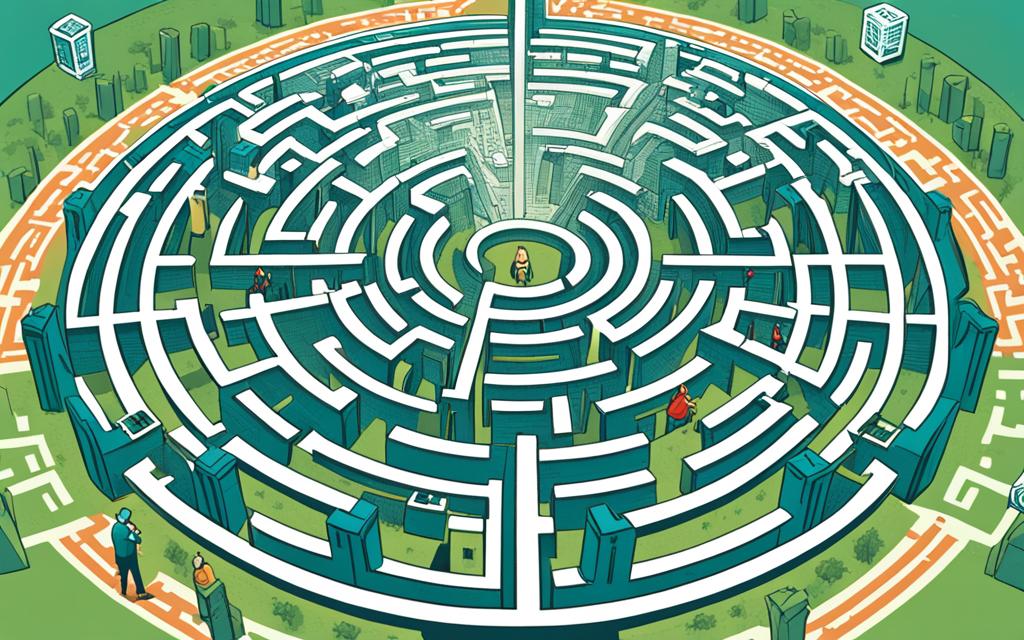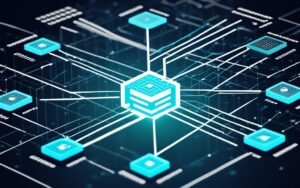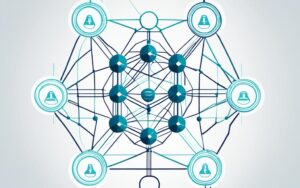Table of Contents
Blockchain is shaking up several sectors with its secure and clear way to check info and deals. It uses decentralization and cryptography to maintain data accuracy. This avoids the need for a middle person, upping security and making transactions quicker.
Confirming info on blockchain is both safe and quick. It’s making trust stronger, cutting fraud, making checks easier and cheaper for groups1. For folks, it’s about managing personal details better, keeping them private, and smoothly moving your info around1. In this, tools like Verifiable Credentials, decentralized identifiers (DIDs), and digital wallets play a big role1.
- Blockchain keeps transactions safely and forever1.
- Things that used to take a week can now happen in seconds thanks to blockchain tech1.
- It’s thought blockchain will cut costs a lot and maybe get rid of intermediaries such as lawyers and bankers1.
- But, getting everyone to use blockchain will take time and effort1.
- As economies go more digital, the need for blockchain becomes clearer for managing contracts and records1.
Blockchain is growing more important in trade, health, and money matters. It keeps trust and clearness thanks to its unique, shared way of working. This way, there’s no single weak point, less need for middle people, and checks are done themselves.
But, big blockchains can have trouble with a lot of transactions, making them slow and costly. The tech also uses a lot of power and costs a fair bit to run2. This leads to concerns about the environment and spending too much money2.
Bitcoin and Ethereum are open to all, being clear and shared. Other blockchains give more control and privacy, picking who can join23. Even so, as more transactions happen, handling them all smoothly is still a problem3. Governments are adjusting the rules to deal with the big change blockchain brings. But, not everyone likes this change, which can slow down its growth2.
Key Takeaways:
- Blockchain makes checking info more trustworthy, fights fraud, and makes checks easier
- Tools like Verifiable Credentials and digital wallets are important for checking things on blockchain
- It ensures our transactions stay safe and forever recorded
- Getting everyone to use blockchain will take time and effort2.
- It’s useful in many areas like making sure goods are genuine, health, and finance
What Is Blockchain Verification?
Blockchain verification is a way to check if digital information is real. It uses blockchain technology. This method is safe and doesn’t need a central authority. It shows that digital credentials and transactions are genuine.
Satoshi Nakamoto created blockchain in 2008. Now we use it for many things like paying, tracking products, and protecting digital documents4. It makes transactions faster and cheaper. Also, it keeps data safe from tampering and cyber attacks4.
Everyone can join the Bitcoin blockchain. They can have a wallet or be a node. But, for finance and banking, private blockchains are better. They make sure only certain people can access the data. Also, there are types called consortium and hybrid blockchains that mix the two main types for special needs5.
In blockchain, records are added but never changed—a bit like a “write-once” system6. They get time stamps and are kept safe from being altered. This makes documents like property titles and court records trustworthy. It helps with legal checks and making sure taxes are right6.
Securing Digital Information with Blockchain
Blockchain keeps digital data safe. It checks for risks, threats, and mistakes in code. This is important for proving when files were made in a legal case6. It helps artists protect their work by showing when it was made. Companies use it to avoid mistakes and to check their payments are right6.
Blockchain is key for DeFi and all digital money5. Smart contracts help make deals happen without errors. They make tracking products better5. Blockchain also improves security, handles contracts smartly, and stops data leaks in many businesses5.
To sum up, blockchain verification is a trusted way to check digital information. It uses blockchain for added trust. This method has many benefits and is important in today’s digital world.
Blockchain Verification System
The blockchain verification system is vital for making sure digital credentials are real and correct. It works with the issuer, the holder, and the verifier. The issuer creates digital diplomas from universities, government ID cards, or job applicant diplomas7.
The holder gets these digital credentials. They can show their digital diploma to a possible employer for proof7.
The verifier is key in the system. They check if the digital credentials are true. This can be an employer, a school, or anyone who needs to confirm someone’s info. The use of blockchain makes this check both safe and fast7.
| Issuer | Holder | Verifier |
|---|---|---|
| Creates and provides digital credentials | Receives and holds digital credentials | Checks and validates digital credentials |
| Universities | Job applicants | Employers |
| Governments | Students | Educational institutions |
The system using blockchain is better than standard ways because it verifies quickly, sometimes in seconds. Other blockchains might take a lot longer. This difference could be because of how many people are using the network or the fees required to use it8.
Adding blockchain also makes the process cheaper and less likely to make mistakes. It helps prevent fraud too8.
Using blockchain in checking things makes them more secure and trustworthy. It lowers the danger of fake work and protects personal information better. This is why it is good for education, health, and finance8.
Checking things the old way can take a long time and cost a lot. It’s also not as safe. Blockchain helps fix these problems by verifying quickly and reliably. It also means we can trust it more and don’t need as much help from others8.
Blockchain Verification Use Cases
The blockchain verification system is used in many fields. Here are some examples:
- Education: It makes sure academic achievements are real. Universities and colleges use it to issue secure digital diplomas and certificates. This helps employers confirm candidates’ credentials8.
- Health and Safety: It checks that medical records are real, keeping patients’ info safe. This makes healthcare info more correct and easy to get to, helping patients8.
- Finance: It makes transactions safe and open, with less chance of fraud. Banks like using it because it makes following rules like KYC and AML simpler. This means transactions can be done safely8.
These examples show how blockchain verification can help in many areas. It makes things more trustworthy and works better89.
How Long Does Blockchain Verification Take?
Blockchain verification time varies. It depends on many factors.
On the Dock blockchain, verification is instant. It takes only seconds to finish10. But, other blockchains might be slower due to several reasons. These include network traffic, block size, and how complicated the transaction is. The fees also play a part in how quickly your transaction gets verified.
Higher fees can make miners check your transaction first, making it quicker10. Bitcoin, for example, takes around an hour to confirm a transaction. This timing is because each block in Bitcoin’s blockchain is confirmed about every 10 minutes10.
Blockchain verification requires advanced math and security steps. These steps keep your information safe. For example, cryptographic algorithms use your private key and transaction details to create a secure signature11. This helps ensure that the transaction is valid. Proof of Work and Proof of Stake are types of checks used to see if the transaction is legit11. And hashing is a way to turn your transaction into a short, unique code. This code makes sure your transaction details stay protected11.
The number of confirmations affects how safe a transaction is. Waiting for about 6 confirmations, which might be an hour on average, is a good idea12. For really big transactions, it’s smarter to wait for even more confirmations. With just 1 confirmation, the risk of something going wrong is small, about 1-2%12.
So, how long blockchain verification takes can change. Many things influence this. But knowing these can help you expect how long your verification will take. Thinking about network traffic, block size, and fees makes for smoother and safer transactions.

| Factors Influencing Blockchain Verification Time | Average Time Frame |
|---|---|
| Network Congestion | Varies |
| Block Size | Varies |
| Complexity of Transaction | Varies |
| Transaction Fees | Varies |
Blockchain Verification Use Cases
Blockchain technology is changing many industries, like education, healthcare, and finance. It makes verifying things easy and secure. This cuts costs, makes things work better, and builds trust. Here’s how it’s making a big difference.
Education
Imagine checking your school certificates was quick and correct every time. This is what blockchain does for education. It’s better than the old ways that were slow and sometimes wrong. Now, schools can quickly check your details are real, which saves time and hassle. Plus, it makes your certificates more trustworthy. (Statistical data from First source)13
Healthcare
Blockchain is also huge in healthcare. It helps make sure patients and doctors are who they say they are. This stops cheats and keeps patients safer. What’s more, it helps make sharing medical info secure, yet private. And, it makes sure medicines and devices are what they claim to be. This makes the whole health system work better and safer for everyone. (Statistical data from Second source)14
Finance
Finance gets a lot from blockchain, too. As more people bank online, making sure they’re real is critical. Blockchain sorts this out safely. It also helps check big money moves are legit, cutting fraud risks. This means big cash deals can happen smooth and safe. (Statistical data from Second source)14
Blockchain is changing the game in education, healthcare, and finance. It makes learning proof quick and right, patient safety bigger, and banking safer. By being open and safe, blockchain is making trust stronger in many fields. This leads to better service, safety, and trust for all. (Statistical data from First source and Second source)1314
| Blockchain Verification Use Cases | Source |
|---|---|
| Education: Credential and transcript verification | First source |
| Healthcare: Doctor and patient identity verification | Second source |
| Finance: Identity verification and proof of funds | Second source |
Why Blockchain Verification Is Needed
Blockchain verification is better than traditional methods. It’s faster, cheaper, and safer. It stops errors and fraud, making trust and truth common in many fields.
It reduces the costs of checking government documents by working as a central checker15. This cuts out middlemen and lowers running costs.
Blockchain boosts trust with digital certificates that can’t be faked15. It’s open and fair, making it solid ground to check digital files like birth certificates. And it does this at a low price15.
Blockchain verification is easier and cheaper than PKI. PKI has usability problems and is often costly15. This makes blockchain a hit for big companies and regular people alike.
Big businesses like third-party signing for documents. But, it’s not great for everyone15. Blockchain checks digital items fast and safely, no matter where you are and without the middlemen.
Trusted timestamping is big with blockchain. It proves when a document was made, stopping arguments15. It means no need for an outside company to mark the time, keeping digital papers real15.
Using cryptographic hash functions, blockchain can make unique IDs15. This adds more protection and makes it strong for checking digital items.
A special blockchain solution keeps proofs of certificates safe, not the original files15. This keeps things private and secure during checks.
In short, blockchain checks beat traditional ones. They are faster, trustworthy, cheaper, and more secure. This makes them great for many areas needing dependable checks.
Blockchain Verification Solutions
Blockchain verification solutions are changing how we check data. They offer instant verification and also cut verification costs. This is done by getting rid of the middlemen.
These solutions use decentralized networks. This makes them fraud-proof and lowers the chance of mistakes. Also, they don’t need other parties to check the data. They are making data checks safer and faster in many fields.
Benefits of Blockchain Verification
Blockchain verification is better than traditional ways in many ways. For starters, it verifies data almost instantly, taking just seconds8. This is important in quick industries like healthcare and finance.
It also cuts down on the costs of checking data. Because there are no long processes or third-parties, it’s cheaper8. This lets companies spend money on other important things.
Using blockchain makes checks safer. It’s very fraud-proof and reduces mistakes16. Since the data can’t be changed, you can trust it more. This is key for personal or financial data checks.
Another big plus is not needing middlemen for checks16. Usually, these checks need someone in the middle. This can slow things down, open the door to fraud, and affect privacy. With blockchain, checks can run directly between users, avoiding these issues.
Use Cases of Blockchain Verification
Blockchain verification helps in many fields. In education, it can make checking qualifications and transcripts safer. This stops fake claims and makes checks better for students, schools, and employers8.
Healthcare can use blockchain checks for making sure whoever you’re talking to online is who they say they are. This is important for online health visits and knowing where food comes from8. It makes things safer for everyone. Providers can be sure of their patients’ identities and check the safety of food more easily.
In finance, blockchain can verify who you are when banking online. It makes online payments safer and faster to go through8. This makes financial activities smoother and more secure for both companies and their clients.
How Dock’s Blockchain Verification Solution Works
Dock uses DIDs, verifiable credentials, and digital wallets for a reliable identity check. This system is both secure and trusted.
DIDs give everyone a unique online ID. This means users keep their personal info safe. It’s a big step for privacy online.
Verifiable credentials, like academic records, are on the blockchain. These have proof from trusted sources. Checking them is quick and easy, no long waits.
Every user can look after their own credentials with a digital wallet. This keeps them safe but easy to use. Sharing info is more secure than ever.
Dock’s blockchain also keeps track of where credentials come from. It makes sure they’re real by checking the sources. This way, everyone knows they can trust the info.
This system makes everything safer. It stops fraud because every step is recorded and can’t be changed17. Plus, anyone can look at the records, which fights sneaky actions17. And in business, it’s great for checking product history and stopping cheats17.
So, Dock’s method uses tech like DIDs and wallets for a better online ID. It means being safe online while making checks easy.
What Is a Blockchain?
A blockchain is a special kind of database. It uses computer programs to create, keep, and update data that lots of people share18. It works without a central place controlling it. Each piece of data is a ‘block’. These blocks are secured by special codes and linked in a chain. This forms a secure, unchangeable list of actions, known as transactions18. Many computers work together to keep this list correct and safe. They must agree on new information added to keep everything secure18.
The main point of a blockchain is that once something is written, it cannot be easily changed. This stops one person or a group from faking records or changing the truth18. Because of this, areas like health care and vaccine distribution use blockchains to protect important information. For example, hospitals use it to keep patient details safe. It’s also used to make sure vaccines reach people fairly and quickly18.
Blockchains also allow for new ways of proving who owns a home or land or even showing who you are without a big boss saying so18. This makes buying or selling things more secure and private, which is good. But, watch out for bad people who might try to trick you using blockchains18.
In the end, blockchain is changing how we trust information. It makes things clear, safe, and trustworthy in many fields18. We’ve only just begun to see how much it can do good in our world today.1
FAQ
How does blockchain verification work?
Blockchain verification confirms credential authenticity using blockchain. A block, in the digital ledger, is approved by many computers. This ensures it cannot be changed. Decentralized identifiers (DIDs) are used for this. They protect privacy and keep data safe.
Who is involved in the blockchain verification system?
The system involves an issuer, a holder, and a verifier. The issuer creates digital credentials. The holder receives them. The verifier checks if they are valid. For instance, universities issue digital diplomas.
How long does blockchain verification take?
Verification time varies. It depends on network traffic, transaction complexity, and fees. With high fees, miners prioritise transactions. This makes verification faster. For Dock blockchain, verification is instant and takes seconds.
What are some use cases for blockchain verification?
It’s used in education for checking credentials. In healthcare, it verifies doctors and patients for online consultations. Finance uses it for digital banking ID checks and big money transfers. These are just a few examples.
Why is blockchain verification needed?
Blockchain verification offers instant checks, lower costs, and safe data. It replaces slow, costly, error-prone methods. It’s more trustworthy and efficient.
What are the benefits of blockchain verification solutions?
It brings instant checks and cuts costs. It keeps data safe and reduces errors. You don’t need third parties for verification. This makes it reliable.
How does Dock’s blockchain verification solution work?
Dock uses DIDs, verifiable credentials, and digital wallets. DIDs help control digital identity. Credentials are securely added for quick checks. Digital wallets keep and manage these credentials safe. Dock also checks the issuer DIDs for credential validity.
What is a blockchain?
A blockchain is a shared, secure ledger among computers. It tracks transactions beyond just money. Chains of blocks make up an unchangeable record. They’re used for many things, like supply chain tracking.
Source Links
- https://hbr.org/2017/01/the-truth-about-blockchain – The Truth About Blockchain
- https://builtin.com/blockchain – Blockchain: What It Is, How It Works, Why It Matters
- https://blockchainreporter.net/which-statement-is-true-about-blockchain/ – Which Statement is True About Blockchain?
- https://www.synopsys.com/glossary/what-is-blockchain.html – What Is Blockchain and How Does It Work? | Synopsys
- https://www.mckinsey.com/featured-insights/mckinsey-explainers/what-is-blockchain – What is blockchain?
- https://www.acronis.com/en-us/technology/blockchain-notary/ – Blockchain Data Authentication – Acronis Cyber Notary Cloud
- https://www.investopedia.com/terms/b/blockchain.asp – Blockchain Facts: What Is It, How It Works, and How It Can Be Used
- https://www.dock.io/post/blockchain-verification – Blockchain Verification: Instant, Secure, and Efficient
- https://www.ibm.com/topics/blockchain – What Is Blockchain? | IBM
- https://investopedia.com/terms/b/blockchain.asp – Blockchain Facts: What Is It, How It Works, and How It Can Be Used
- https://www.solulab.com/how-blockchain-verification-work/ – Blockchain Verification Process: Ensuring Data Integrity
- https://www.coincenter.org/education/crypto-regulation-faq/how-long-does-it-take-for-a-bitcoin-transaction-to-be-confirmed/ – How long does it take for a Bitcoin transaction to be confirmed?
- https://bootcamp.berkeley.edu/blog/blockchain-use-cases/ – 6 Blockchain Use Cases in 2023: Learn Blockchain Today – Berkeley Boot Camps
- https://consensys.io/blockchain-use-cases – Blockchain Use Cases and Applications by Industry
- https://medium.com/coinmonks/blockchain-based-document-timestamping-and-verification-1bafd36b6c1f – Blockchain-Based Document Timestamping and Verification
- https://consensys.io/blockchain-use-cases/digital-identity – Blockchain for Digital Identity | Real World Blockchain Use Cases | Consensys
- https://www.ibm.com/topics/benefits-of-blockchain – What are the Benefits of Blockchain? | IBM
- https://www.finra.org/investors/insights/what-blockchain – What Is a Blockchain, and Why Should I Care?








